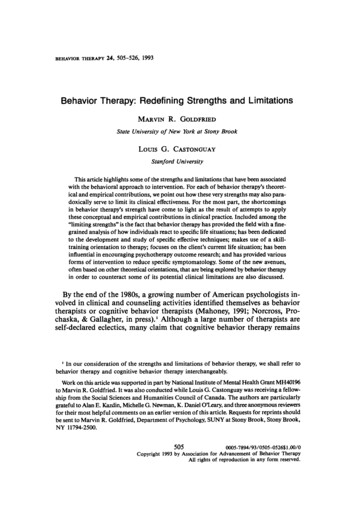
Transcription
BEHAVIOR THERAPY 24, 505-526, 1993Behavior Therapy: Redefining Strengths and LimitationsMARVIN R.GOLDFRIEDState University of New York at Stony BrookLotnsG.CASTONGUAYStanford UniversityThis article highlights some of the strengths and limitations that have been associatedwith the behavioral approach to intervention. For each of behavior therapy's theoretical and empirical contributions, we point out how these very strengths m a y also paradoxically serve to limit its clinical effectiveness. For the most part, the shortcomingsin behavior therapy's strength have come to light as the result o f attempts to applythese conceptual and empirical contributions in clinical practic Included a m o n g the"limiting strengths" is the fact that behavior therapy has provided the field with a finegrained analysis of how individuals react to specific life situations; has been dedicatedto the development and study o f specific effective techniques; makes use o f a skilltraining orientation to therapy; focuses on the client's current life situation; has beeninfluential in encouraging psychotherapy outcome research; a n d has provided variousforms o f intervention to reduce specific symptomatology. Some of the new avenues,often based on other theoretical orientations, that are being explored by behavior therapyin order to counteract some o f its potential clinical limitations are also discussed.By the end of the 1980s, a growing number of American psychologists involved in clinical and counseling activities identified themselves as behaviortherapists or cognitive behavior therapists (Mahoney, 1991; Norcross, Prochaska, & Gallagher, in press)) Although a large number of therapists areself-declared eclectics, many claim that cognitive behavior therapy remainsIn our consideration o f the strengths and limitations of behavior therapy, we shall refer tobehavior therapy a n d cognitive behavior therapy interchangeably.Work on this article was supported in part by National Institute of Mental Health Grant MH40196to Marvin R. Goldfried. It was also conducted while Louis G. Castonguay was receiving a fellowship from the Social Sciences and Humanities Council of Canada. The authors are particularlygrateful to Alan E. Kazdin, Michelle G. Newman, K. Daniel O'Leary, and three anonymous reviewersfor their most helpful comments on an earlier version of this article. Requests for reprints shouldbe sent to Marvin R. Goldfried, Department of Psychology, SUNY at Stony Brook, Stony Brook,NY ht 1993 by Association for Advancement of Behavior TherapyAll rights of reproduction in any form reserved.
506GOLDFRIED AND CASTONGUAYone o f their major methods of intervention. Moreover, psychodynamic andexperiential therapists alike have been pointing to the behavioral contributions to their own approaches (e.g., Anchin, 1982; Barber & Luborsky, 1991;Bouchard & Derome, 1987; Greenberg, Safran, & Rice, 1989; Landsman, 1974;Messer, 1986; Norcross, 1988; Reid, 1987; Saint-Arnaud, 1987; Strupp, 1983;Wachtel, 1977). It seems fair to say, therefore, that a large percentage o f psychotherapists have been directly or indirectly influenced by behavior therapy.Having won recognition within the larger therapeutic community, behaviortherapists have begun to evaluate their own shortcomings (e.g., Franks, 1984;Mahoney, 1980, 1991; Thoresen & Coates, 1978). Whereas behavior therapywas once believed to be successful in nine out of ten cases (Wolpe, 1964), thereis now a healthy recognition that our techniques have a more modest impact.Behavior therapy is now also more open about its failures and, much to itscredit, has attempted to learn from them (Foa & Emmelkamp, 1983). All thispoints to what we believe to be a positive trend in our ongoing growth anddevelopment.Despite our self-examination and self-criticism, behavior therapy has remained a major force in psychotherapy. By developing new assessment andtreatment procedures, we have broken set with numerous traditions, and indoing so, have provided the field with undeniable contributions. But behaviortherapy, like other therapeutic orientations, is imperfect. It is not our purposehere to comprehensively review the status of behavior therapy. Instead, theintent o f the present article is to highlight some of the strengths and limitations o f the behavioral movement. For each of behavior therapy's contributions, we shall point out, in particular, how these very strengths may also paradoxically serve to limit its clinical effectiveness. Although our focus is onbehavior therapy, it should not be concluded that all of these assets and liabilities are unique to this one orientation. Our goal, however, is to offer this evaluation o f a system about which we know best. Nor do we wish to foster a uniformity myth, implying that each strength and limitation of behavior therapyreflects a comparable asset or liability that inevitably exists in all clinical situations or disorders. Still, we believe that general and rather global potentiallimitations of behavior therapy have often followed from its strengths.Consistent with the experimental roots of behavior therapy, its major contributions have been influenced by basic and applied research, as well as bythe theoretical conceptualizations associated with these findings. A point thatwe would like to underscore, however, is that it has been our attempts as behavior therapists to apply behavioral, conceptual and empirical contributionsin clinical practice that have highlighted the shortcomings in behavior therapy'sstrengths. Thus, the limitations may be more in the way we conceptualize anddo research than in the way behavior therapy is actually practiced. Fortunately,new avenues are being explored within behavior therapy in order to counteractsome of its limitations. As we will point out, these avenues are often basedon other theoretical orientations.
REDEFINING STRENGTHS AND LIMITATIONS507Strengths, Limitations and New DirectionsStrength #1: Behavior Therapy Characteristically Provides Us with aFine-Grained Analysis o f How Individuals React toSpecific Life SituationsReflecting its well-established experimental roots, behavior therapy approached complex and debilitating human problems by dimensionalizing themso that they could be thought of in terms o f variables, which may be definedin very specific ways. Bandura's (1986) concept of "reciprocal determinism,"for instance, has provided a fine-grained analysis of how behavioral, cognitive, and environmental variables are all mutually influential in understandinghuman functioning. At a clinical level, the focus on specific determinants ofhuman behavior, rather than on global characteristics of clients, has openednew therapeutic avenues. Thus, instead of concluding that the fearful individualwas "not ready to change," behavior therapists created hierarchies of increasingly more anxiety-producing situations that would allow for an ongoingprogressive reduction in anxiety. This behavioral emphasis on specificity ismuch like looking at problematic reactions under a high-magnification microscope. We have encouraged a detailed examination of problematic thoughts,feelings, and behaviors in specific life situations, and a good deal of clinicaland research effort has been devoted to developing both methods for the assessment o f these molecular interactions and procedures for changing them.Limitations. Even though this has clearly been one of our strengths, it mayalso result in a limitation. There is a trade-off involved when we engage ina microscopic analysis; the higher the magnification, the narrower the fieldo f vision. Thus, one of the shortcomings of much of behavior therapy hasbeen its failure to look at patterns of b e h a v i o r - patterns that may span differenttimes and settings in a client's life. This tradition of situational specificity maybe readily traced to the early writings of Mischel (1968), who established thebehavioral view of personality as one that emphasized what people '"did" invarious situations, rather than what they "had" more globally. Disavowingsuch constructs as "traits," "needs," or "motives," Mischel (1969) went on tosuggest that "what people do in any situation may be altered radically evenby seemingly minor variations in prior experiences or slight modifications instimulus attributes or in the specific characteristics o f the evoking situation"(p. 1016).In response to this argument against behavioral consistencies, Wachtel (1973)maintained that individuals who are likely to be seen in a clinical context almost by definition manifest behavior patterns that typically do not vary according to situation. Wachtel convincingly argued that it is precisely becauseo f their failure to easily alter how they respond to situational changes thattheir functioning is impaired. It should be noted that in a later formulationof this issue, Mischel and Peake (1982) have suggested that although crosssituational consistency is unlikely, the temporal stability of an individual's prototype characteristics may be found.
508GOLDFRIED A N D C A S T O N G U A YN e w directions. There are a number of ways in which we can become moresensitive to more general patterns in our clients' lives. Wachtel (1977) has suggested that a psychodynamically oriented approach, particularly one that isinterpersonal in emphasis, can be valuable in complementing behavior therapyby alerting it to the ways that individual interaction patterns may create problems in clients' lives. Also of relevance in this regard is the clinical-experimentalwork o f Benjamin (1982), which characterizes reciprocal interpersonal relationship patterns along the dimensions of affiliation and control, as they occurboth within and outside the context of therapy sessions. Focusing on the samedimensions of affiliation and control, Anchin (1987) has urged behavior therapists to incorporate several constructs and methods developed by interpersonal theorists within their empirical functional analysis of behavior. He arguesthat such expanded functional analyses would delineate important social factorsthat are generally disregarded in the current behavioral assessment of the antecedents, consequences, and nature of maladaptive behaviors.The contributions of a system approach, as reflected in current trends withinbehavioral marital therapy, may also be viewed as a move to alleviate the microscopic limitation within behavior therapy. By looking at more global patterns o f marital interaction- like using a lower magnification microscope witha broader f i e l d - we can have a clearer picture of the overall context prior toour use of a fine-grain analysis of the relationship. Enlarging our focus o fintervention by addressing the client's interpersonal system may also improvetherapeutic effectiveness. A review o f the relative merits of individual and/ormarital interventions by Jacobson, Holtzworth-Munroe, and Schmaling (1989)has indicated that behavioral marital therapy is as effective as cognitive behavior therapy for the treatment of depressive symptoms and, additionally,has a greater impact on marital satisfaction. As noted by Jacobson et al. (1989),considering the role of marital discord in precipitating and maintaining depression, the improvement of marital communication patterns might significantlyreduce the client's relapse. In an attempt to capitalize on the potential synergistic effect o f individual and marital interventions, Addis and Jacobson (1991)and Beach, Sandeen, and O'Leary (1990) have proposed theoretical and clinical guidelines to integrate cognitive behavior therapy and behavioral maritaltherapy for the treatment of depression. As a function of social support andother possible factors, the involvement of the spouse in the treatment ofagoraphobia seems to increase the therapeutic effect of behavioral exposuremethods (Barlow, 1988). Jacobson et al. (1989) have underscored this point,also reporting studies suggesting that the addition of marital therapy to traditional outpatient treatment can provide an effective treatment for both alcohol-abuse problems and the marital difficulties that are implicated in theseproblems.Although behavioral marital therapy addresses important elements of theclient's interpersonal system (e.g., the couple's reciprocal use of punishments),its focus of intervention is still perceived by some behavior therapists as toorestrictive. Weiss (1980), for instance, has argued that by placing too muchemphasis on the response or skill deficits of the partners (e.g., lack of positivereinforcers, communication-skills deficits), behavioral marital therapists have
REDEFINING STRENGTHS A N D LIMITATIONS509failed to consider the complex "dynamics" of the marital relationship (e.g.,struggle for control, motivation to maintain relationship homeostasis). Sucha narrow focus, according to Weiss, may account for problems of noncompliance observed in behavioral marital therapy. In order to deal with couple resistance to change, Weiss has elaborated a "Behavioral Systems Approach"that integrates strategic or systemic techniques (e.g., reframing, paradoxicalintention, confusion) with the application of behavioral marital therapy.Strength #2: Behavior Therapy Has Typically Been Dedicated toDevelopment and Study of Specific Effective TechniquesAs behavior therapists, we have at our disposal a wide array o f differenttechniques that we can use when encountering different clinical problems. Because the methods are fairly well specified, they can be readily taught,researched, and perfected. From the early efforts with systematic desensitization and behavior rehearsal to the more current work on exposure, communication training, and cognitive behavioral interventions, a considerable amountof clinical and research attention has been given to the development and studyof different behavioral techniques. Behavioral methods of intervention havebeen subjected to extensive research, and many have been demonstrated tobe effective in treating various clinical problems. Here, too, behavior therapycan have two limitations in its strength, in that less attention has been paidto (a) individual client and therapist differences, and (b) the underlying principle o f change. Each of these limitations is considered, in turn, below.Limitation A: Individual differences. With its emphasis on techniques, thebehavior therapy literature may lead one to conclude that these methods canbe adequately applied to all clients by all therapists. In this respect, we mayhave inadvertently contributed to maintaining one of the uniformity mythsso aptly identified by Kiesler (1966). Consistent with the group comparisonmethodology that has characterized much of the outcome research on behaviortherapy, individual differences have been viewed as "error" or "noise." Thistendency to neglect individual differences, as most clinicians well know, canreadily undermine the effectiveness o f our methods. The tacit assumption thatindividual differences play a relatively minor role may very well be the resultof what we read in the research literature, where, for experimental purposes,subjects are randomly assigned to different treatment procedures. The clinicalresearch dichotomy is most evident here; we know of no clinical behavior therapist who randomly assigns a client to an intervention.New directions. This shortcoming has started to change, especially regardingthe recognition of clients' individual differences along clinically meaningfuldimensions. Clinical researchers, for example, are considering the interactionbetween the client's locus of control and the therapist's style of intervention.Thus, with highly reactant clients, a directive approach on the part of a therapist is likely to result in behavioral noncompliance (e.g., Beutler & Consoli,1992; Shoham-Solomon, Avner, & Neeman, 1989). Beck (1983) has writtenabout the sociotropic versus the autonomous client and the specific kinds o flife situations that make them prone to depressive reactions. Karoly (1980)has described a number of individual differences in clients that may be rele-
510GOLDFRIED AND CASTONGLIAYvant at various phases of the therapy process, from the recognition of a problem,to making a commitment to change, to the maintenance of change. Glass andArnkoff (1982) have argued for matching cognitive behavioral interventionswith specific client styles of functioning (e.g., cognitive vs. action-oriented).Following this lead, attention to individual differences in the cognitive behavioral treatment of anxiety disorders has begun to yield promising findings.For example, Michelson (1986) found that agoraphobic clients who receivedinterventions that were designed to address their specific anxiety response profile(e.g., cognitive, behavioral, or physiological) improve more than those whosecognitive behavioral interventions failed to address these individual differences.Preliminary findings by Nelson-Gray (1991) and her research group with unipolar depression similarly support the superiority of cognitive behavioral interventions that match the response class associated with the specific client'sdepression (e.g., irrational beliefs, social skill deficits, infrequent pleasant activities).Much less effort has been made to identify specific therapist factors thatshould guide the selection and administration o f particular behavioral interventions. This is noteworthy in light of research reviews pointing out thesignificant effect of certain therapist variables (e.g., personality, psychologicaladjustment) on client's improvement or deterioration (Crits-Cristophe et al.,1991; Lambert, 1989). An exception is the recent attention paid to the roleof the therapist's personal reactions to the therapeutic relationship, which willbe addressed in a later section of this article.Limitation B: Overlooldng principle o f change. To the extent that we asbehavior therapists think in terms of techniques, we may also at times losesight of the underlying principle of change reflected in the technique. The failureto look at the underlying principle can, in turn, prevent us from consideringand experimenting with techniques that might be even more effective in implementing the change principle. Consider the clinical example o f a 35-yearold female therapist whom we saw in treatment. Although she seemed to beclinically competent, she was very unsure of her ability as a therapist, indicating that it had been several years since she worked in a clinical capacity.We suggested that perhaps what was needed was some practice, and we urgedher to take the therapist's chair and take the role of the therapist, talking toan imaginary c l i e n t - a client who was very unsure about her ability to dotherapy. She did a good job as therapist in this role-play situation and, in fact,was able to help herself in developing greater confidence in her ability to resume her work therapeutically. The question is, was this a behavioral roleplaying technique that we used, or was it a gestalt two-chair exercise? Ourown view is that it is less relevant what we label our techniques, and moreimportant that we identify their underlying principle of change. In the example given above, the important principle was to help the client obtain amore realistic vantage point on what she had been construing in a subjectiveand distorted way.New directions. Recent contributions have illustrated how techniques derived from different theoretical models can be used to implement the samestrategies or processes o f change (e.g., Goldfried 1980a; Goldfried & Padawer,
REDEFINING STRENGTHS A N D LIMITATIONS5111982; Prochaska & DiClemente, 1984). Moreover, this principle could probably be implemented by any of a number of different methods. Once psychotherapists start to think more in terms o f principles of change, rather thanin terms of the techniques prescribed by their preferred theory, they allow themselves the option o f considering a far greater pool o f intervention methods.In nonbehavioral treatments, numerous clinical procedures have indeed beendeveloped to implement different principles o f change that are crucial to behavior therapy, such as the facilitation of corrective experiences, ongoing realitytesting, and, as mentioned above, the provision of a new perspective on selfand the world (Brady et al., 1980). Consequently, we may well find that theseintervention methods are not inconsistent with a behavioral model of change,and can complement our clinical repertoire (cf. Lazarus, 1981). In addition,some of these interventions may be more effective than the cognitive behavioraltechniques we have developed for certain clinical problems. We should, forexample, consider using the two-chair gestalt technique when dealing withproblematic choices in a client's life, as it has been shown to be more effectivethan problem-solving techniques (Clarke & Greenberg, 1986).Strength #3: Behavior Therapy Makes Use o f a Skill TrainingOrientation to TherapyIn rejecting the disease model of psychological problems, behavior therapyhas instead adopted an educational model, whereby clients are taught skillsfor coping with realistic life problems (Goldfried, 1980b). Thus, we serve notas healers, but rather as teachers, trainers, and consultants. As a reaction againstearly criticism that behavior therapy was undermining the client's autonomyand freedom of choice, we as behavior therapists developed a host of selfregulatory methods that could enable clients to function as their own therapists (Goldfried & Merbaum, 1973; Thoresen & Mahoney, 1974). Includedamong such coping methods have been relaxation, problem solving, cognitiverestructuring, and interpersonal communication skills. Not only have thesemethods been useful within the clinical context, but they also have served asthe bases for psychoeducational training programs, thereby reaching a broaderpopulation and having more far-reaching applications.Limitation. Although this skill training emphasis has served us well in dealingwith a number of clinical problems (e.g., unassertiveness), it may be limitingat times by fostering a tendency to lapse into a didactic and overly directiveapproach to intervention. In this regard, research findings by Patterson andForgatch (1985) showed that therapeutic efforts at "teaching" parents to workmore effectively with their children resulted in more noncompliance than didattempts at "support" and "facilitation." We have already alluded to the notion of psychological reactance and how that is likely to occur with certainindividuals for whom there is a high internal locus of control. A clinical example may serve to illustrate this point a bit more vividly.Take the case o f a 32-year-old, somewhat obsessional male high-schoolteacher with a number of presenting problems. Should he marry? How wellcan he handle problems at work? How comfortable is he in social situations?He had been seen in the past by a number of other behavior therapists, all
512G O L D F R D AND CASTONGUAYquite skilled. Although improvements were observed, changes never seemedto be maintained over time. In working with him clinically, we encounteredthe same problems; changes would occur, but they would not last. It was onlyafter a while that we realized that our didactic approach to teaching assertion,relaxation, and other coping skills was, in fact, responsible not only for ourown failure to bring about maintenance, but probably everyone else's as well.By being directive in teaching him coping skills, we were also inadvertentlygiving him the message that he needed directing, thereby unwittingly undermining his own self-efficacy. Once we became aware of the implicit messagethat was being conveyed by the nature of the therapeutic interaction, it provideda turning point in therapy. Our strategy was to become very nondirective, onthe assumption that he already had knowledge of and experience in the useof coping skills, and that his requests for direction and guidance, if satisfied,would only reinforce his lack of independence. Once the therapeutic relationship was based on a more nondirective footing, there was a very discerniblepositive change in his functioning.N e w directions. Although cognitive behavior therapists have written aboutthe importance of the collaborative relationship (e.g., Beck, Rush, Shaw, &Emery, 1979; Goldfried & Davison, 1976), we have been somewhat slow torecognize the inherent complexity and therapeutic value of the working alliance (see Bordin, 1979). Emerging from a psychodynamic tradition, the construct of the working alliance has been shown to predict the client's improvement in behavior and cognitive behavior therapy (see Gaston, 1990; Raue &Goldfried, in press). Interestingly enough, a study of expert therapists (Raue,Castonguay, & Goldfried, in press) found cognitive behavior therapists to berated significantly higher on an observer measure of the alliance than werepsychodynamic therapists. Despite this unexpected finding, it may well be thatwe as behavior therapists still have a lot to gain from the expertise of othertherapists, especially when confronted with potential or actual strains in thetherapeutic relationship. Safran, Crocker, McMain, and Murray (1990) havealready illustrated the beneficial contributions to cognitive behavior therapyfrom psychodynamic and humanistic orientations by defining specific signsof alliance ruptures (e.g., expression of negative feelings), as well as the useof several strategies to address such strains (e.g., awareness of one's own feelings;adopting an attitude of "participant-observer").Systematic efforts to establish and maintain a therapeutic alliance have particularly been emphasized in the cognitive behavioral approach to dealing withpersonality disorders. Linehan and her colleagues (Koerner & Linehan, 1992;Linehan, 1987), for example, have observed that challenging the irrational beliefs of borderline patients, or encouraging new ways of behaving, unwittinglyserves to repeat the invalidating reactions of others that have painfully characterized their early social learning histories. By focusing on how borderlinepatients need to change, observes Linehan, the behavior therapist faces thedanger of sending the latent message that they are deficient. Thus, the firststrategy or her "dialectical behavior therapy" consists of establishing an accepting, empathic, and nondirective relationship. It is only after a strongworking alliance has been secured with this patient population, and with their
R E D E F I N I N G STRENGTHS A N D LIMITATIONS513feeling that they have been fully accepted for just the way they are, that moretraditional cognitive behavioral techniques are implemented to help them acquire the coping skills that they generally lack.Strength #4: Behavior Therapy Primarily Focuses on the Client'sCurrent Life SituationIn behavioral interventions, the emphasis is on the "here and now" in theclient's life, rather than the "there and then." In our attempt to avoid focusingon early childhood experiences-with the notable exception of dealing withissues of early a b u s e - we as behavior therapists have dealt primarily with whatis going on between sessions in the person's current life. The objective is toprovide homework assignments, so that clients can take behavioral risks andhave success experiences. As a result of this focus on between-session experiences, behavior therapy has been successful in shortening the course ofinterventions. However, it may also have kept us from paying sufficient attention to two other distinct arenas: (a) in-session issues and (b) our own reactions to the client. Each o f these limitations is considered, in turn, below.Limitation A: In-session issues. Because of our focus on between-sessionproblems or successes in the client's life, we may at times overlook in-sessionissues, sometimes to the detriment of therapeutic progress. Take the exampleo f a 53-year-old depressed accountant who had a long history of previous psychodynamic therapy. He came to us because he wanted a more directive approach and something that would focus more on his current life situation.When assertiveness training was presented as a relevant approach in helpinghim to get better control over his current life and thereby alleviate his depression, the client responded with ambivalence. Although he wanted somethingthat was different from what he had been doing in his past therapy, he continued to emphasize the need to get further insight into the developmentalorigins o f his problem. We explained, however, that the primary focus wouldbe on encouraging more structured types of success experiences. Althoughthe client agreed to the intervention procedures, he resisted following throughon homework assignments. The client became increasingly more depressed,and indicated that he was not getting what he wanted from therapy. Preciselybecause he was so unassertive, he had difficulty in showing his disappointment and anger directly. It was only after the focus was shifted to this insession issue, and he was encouraged to express his anger toward the therapistmore directly, that he finally acknowledged that he could benefit from assertiveness training. From that point on, he became more cooperative in goingout and asserting himself in various life situations and started to feel muchmore empowered in his interpersonal relationships.New directions. We noted earlier the importance of being mindful o f howour directive interventions may at times lead to a client's reactance, as wellas the need to maintain a good working alliance. At this point, we suggestthat it is important for behavior therapy to acknowledge more generally thatthe therapeutic relationship can often provide us with a sample o f the client'sproblem. That is, our interaction with clients can reflect a stimulus
has indicated that behavioral marital therapy is as effective as cognitive be- havior therapy for the treatment of depressive symptoms and, additionally, has a greater impact on marital satisfaction. As noted by Jacobson et al. (1989), considering the role of










